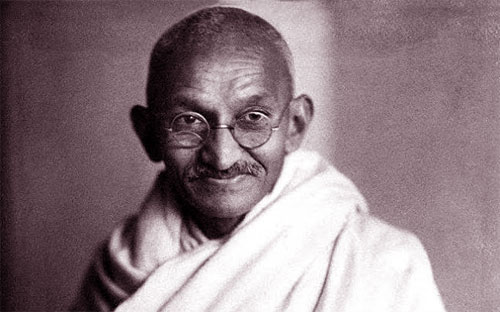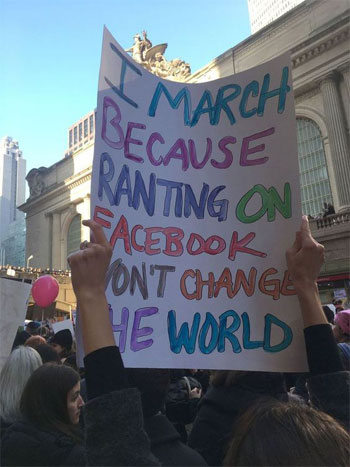198 Violent Methods to Fight Evil

Gandhi led by example through his spiritual and political struggle, or his “experiments with truth” as he called them. He preached non-violence, AHIMSA in SANSKRIT. AHIMSA’s precept of “cause no injury” includes one’s deeds, words, and thoughts. According to Gandhi the winner of human conflicts was the one that refrain from using violence – that moral power beats the power of force.
More recently, there are the works of Gene Sharp, the founder of the Albert Einstein Institution, a non-profit organization dedicated to advancing the study of nonviolent action. He is known for his extensive writings on nonviolent struggle, which have influenced numerous anti-government resistance movements around the world.
When you use the methods of non-violence against an oppressive state you might not only end up as the moral winner, but also as the final victor. Sharp’s fundamental belief is that any power structure relies upon the subjects’ obedience to the orders of the ruler(s). If enough subjects do not obey, rulers have no power – no matter how many guns they have.
Sharp cites the insight of Étienne de La Boétie (1530–1563), that if the subjects of a particular state recognize that they are the source of the state’s power, they can refuse their obedience and their leader(s) will be left without power.
Below you’ll find a small part of Gene Sharp’s work in the form of 198 methods of non-violence. If you want to learn more about this philosophy, check out some of his writings that can be accessed for free through the Albert Einstein Institute. For example, read From Dictatorship to Democracy, which is just as relevant if you face oppression from a totalitarian democratorship.
Here’s the intro to the methods: “Far too often people struggling for democratic rights and justice are not aware of the full range of methods of nonviolent action. Wise strategy, attention to the dynamics of nonviolent struggle, and careful selection of methods can increase a group’s chances of success.”
Gene Sharp’s researched and catalogued these 198 methods and provided a rich selection of historical examples in his seminal work, The Politics of Nonviolent Action (3 Vols.) Boston: Porter Sargent, 1973.
The Methods of Nonviolent Protest and Persuasion
Formal Statements
1. Public speeches
2. Letters of opposition or support
3. Declarations by organizations and institutions
4. Signed public statements
5. Declarations of indictment and intention
6. Group or mass petitions
Communications with a Wider Audience
7. Slogans, caricatures, and symbols
8. Banners, posters, and displayed communications
9. Leaflets, pamphlets, and books
10. Newspapers and journals
11. Records, radio, and television
12. Skywriting and earthwriting
Group Representations
13. Deputations
14. Mock awards
15. Group lobbying
16. Picketing
17. Mock elections
Symbolic Public Acts
18. Displays of flags and symbolic colors
19. Wearing of symbols
20. Prayer and worship
21. Delivering symbolic objects
22. Protest disrobings
23. Destruction of own property
24. Symbolic lights
25. Displays of portraits
26. Paint as protest
27. New signs and names
28. Symbolic sounds
29. Symbolic reclamations
30. Rude gestures
Pressures on Individuals
31. “Haunting” officials
32. Taunting officials
33. Fraternization
34. Vigils
Drama and Music
35. Humorous skits and pranks
36. Performances of plays and music
37. Singing

Processions
38. Marches
39. Parades
40. Religious processions
41. Pilgrimages
42. Motorcades
Honoring the Dead
43. Political mourning
44. Mock funerals
45. Demonstrative funerals
46. Homage at burial places
Public Assemblies
47. Assemblies of protest or support
48. Protest meetings
49. Camouflaged meetings of protest
50. Teach-ins
Withdrawal and Renunciation
51. Walk-outs
52. Silence
53. Renouncing honors
54. Turning one’s back
The Methods of Social Noncooperation
Ostracism of Persons
55. Social boycott
56. Selective social boycott
57. Lysistratic nonaction
58. Excommunication
59. Interdict
Noncooperation with Social Events, Customs, and Institutions
60. Suspension of social and sports activities
61. Boycott of social affairs
62. Student strike
63. Social disobedience
64. Withdrawal from social institutions
Withdrawal from the Social System
65. Stay-at-home
66. Total personal noncooperation
67. “Flight” of workers
68. Sanctuary
69. Collective disappearance
70. Protest emigration (hijrat)
The Methods of Economic Noncooperation: Economic Boycotts
Actions by Consumers
71. Consumers’ boycott
72. Nonconsumption of boycotted goods
73. Policy of austerity
74. Rent withholding
75. Refusal to rent
76. National consumers’ boycott
77. International consumers’ boycott
Action by Workers and Producers
78. Workmen’s boycott
79. Producers’ boycott
Action by Middlemen
80. Suppliers’ and handlers’ boycott
Action by Owners and Management
81. Traders’ boycott
82. Refusal to let or sell property
83. Lockout
84. Refusal of industrial assistance
85. Merchants’ “general strike”
Action by Holders of Financial Resources
86. Withdrawal of bank deposits
87. Refusal to pay fees, dues, and assessments
88. Refusal to pay debts or interest
89. Severance of funds and credit
90. Revenue refusal
91. Refusal of a government’s money
Action by Governments
92. Domestic embargo
93. Blacklisting of traders
94. International sellers’ embargo
95. International buyers’ embargo
96. International trade embargo
The Methods of Economic Noncooperation: The Strike

Symbolic Strikes
97. Protest strike
98. Quickie walkout (lightning strike)
Agricultural Strikes
99. Peasant strike
100. Farm Workers’ strike
Strikes by Special Groups
101. Refusal of impressed labor
102. Prisoners’ strike
103. Craft strike
104. Professional strike
Ordinary Industrial Strikes
105. Establishment strike
106. Industry strike
107. Sympathetic strike
Restricted Strikes
108. Detailed Strike
109. Bumper strike
110. Slowdown strike
111. Working-to-rule strike
112. Reporting “sick” (sick-in)
113. Strike by resignation
114. Limited strike
115. Selective strike
Multi-Industry Strikes
116. Generalized strike
117. General strike
Combination of Strikes and Economic Closures
118. Hartal
119. Economic shutdown
The Methods of Political Noncooperation
Rejection of Authority
120. Withholding or withdrawal of allegiance
121. Refusal of public support
122. Literature and speeches advocating resistance
Citizens’ Noncooperation with Government
123. Boycott of legislative bodies
124. Boycott of elections
125. Boycott of government employment and positions
126. Boycott of government depts., agencies, and other bodies
127. Withdrawal from government educational institutions
128. Boycott of government-supported organizations
129. Refusal of assistance to enforcement agents
130. Removal of own signs and placemarks
131. Refusal to accept appointed officials
132. Refusal to dissolve existing institutions
Citizens’ Alternatives to Obedience
133. Reluctant and slow compliance
134. Nonobedience in absence of direct supervision
135. Popular nonobedience
136. Disguised disobedience
137. Refusal of an assemblage or meeting to disperse
138. Sit-down
139. Noncooperation with conscription and deportation
140. Hiding, escape, and false identities
141. Civil disobedience of “illegitimate” laws
Action by Government Personnel
142. Selective refusal of assistance by government aides
143. Blocking of lines of command and information
144. Stalling and obstruction
145. General administrative noncooperation
146. Judicial noncooperation
147. Deliberate inefficiency and selective noncooperation by enforcement agents
148. Mutiny
Domestic Governmental Action
149. Quasi-legal evasions and delays
150. Noncooperation by constituent governmental units
International Governmental Action
151. Changes in diplomatic and other representations
152. Delay and cancellation of diplomatic events
153. Withholding of diplomatic recognition
154. Severance of diplomatic relations
155. Withdrawal from international organizations
156. Refusal of membership in international bodies
157. Expulsion from international organizations
The Methods of Nonviolent Intervention
Psychological Intervention
158. Self-exposure to the elements
159. The fast
a. Fast of moral pressure
b. Hunger strike
c. Satyagrahic fast
160. Reverse trial
161. Nonviolent harassment

Physical Intervention
162. Sit-in
163. Stand-in
164. Ride-in
165. Wade-in
166. Mill-in
167. Pray-in
168. Nonviolent raids
169. Nonviolent air raids
170. Nonviolent invasion
171. Nonviolent interjection
172. Nonviolent obstruction
173. Nonviolent occupation
Social Intervention
174. Establishing new social patterns
175. Overloading of facilities
176. Stall-in
177. Speak-in
178. Guerrilla theater
179. Alternative social institutions
180. Alternative communication system
Economic Intervention
181. Reverse Strike
182. Stay-in Strike
183. Nonviolent land seizure
184. Defiance of Blockades
185. Politically Motivated Counterfeiting
186. Preclusive Purchasing
187. Seizure of assets
188. Dumping
189. Selective patronage
190. Alternative markets
191. Alternative transportation systems
192. Alternative economic institutions
Political Intervention
193. Overloading of administrative systems
194. Disclosing identities of secret agents
195. Seeking imprisonment
196. Civil disobedience of “neutral” laws
197. Work-on without collaboration
198. Dual sovereignty and parallel government
yogaesoteric
January 15, 2019
